BUSN20016: Challenges in Woolworths Recruitment and Selection
VerifiedAdded on 2022/08/14
|19
|4380
|258
Report
AI Summary
This report delves into the recruitment and selection challenges faced by Woolworths, a major retail company. It begins with an introduction highlighting the importance of effective HR practices and the impact of challenges like elongated time-to-fill on business operations. The report identifies the problem statement as the need for efficient recruitment, driven by competitive market demands. The aim is to assess the effectiveness of talent communities in addressing the time-to-fill issue. Objectives include examining need analysis frequency, strategies for talent community expansion, candidate session approaches, and ethical code improvements. The research questions explore these aspects in detail. The scope focuses on Woolworths and associated partners, utilizing primary and secondary data. Justification emphasizes the potential impact on business sustainability, especially regarding customer turnover. The conceptual framework outlines the relationship between structure, process, quality, and outcomes like increased confidence and reduced waiting time. A literature review covers recruitment and selection processes, challenges, and relevant theories of motivation (Maslow's and Herzberg's) and leadership. The methodology section outlines the research philosophy, design, approach, data collection methods, sampling, data analysis, and ethical considerations. The report concludes with a budget and an action plan, providing a comprehensive overview of the research and its practical implications for improving Woolworths' recruitment and selection strategies.

Running head: MANAGEMENT
BUSINESS RESEARCH
Name of the student:
Name of the university:
Author note:
BUSINESS RESEARCH
Name of the student:
Name of the university:
Author note:
Paraphrase This Document
Need a fresh take? Get an instant paraphrase of this document with our AI Paraphraser
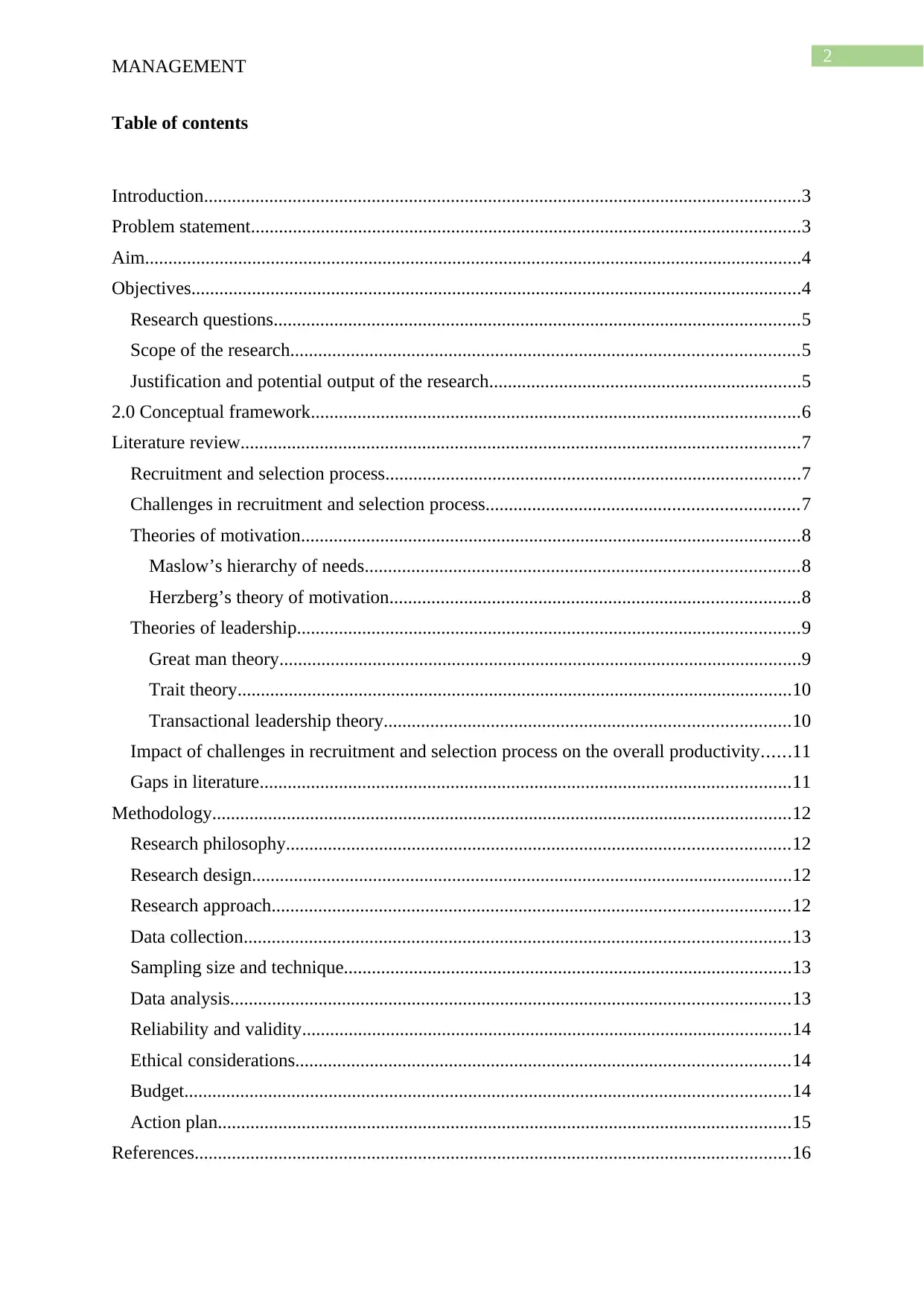
2
MANAGEMENT
Table of contents
Introduction................................................................................................................................3
Problem statement......................................................................................................................3
Aim.............................................................................................................................................4
Objectives...................................................................................................................................4
Research questions.................................................................................................................5
Scope of the research.............................................................................................................5
Justification and potential output of the research...................................................................5
2.0 Conceptual framework.........................................................................................................6
Literature review........................................................................................................................7
Recruitment and selection process.........................................................................................7
Challenges in recruitment and selection process...................................................................7
Theories of motivation...........................................................................................................8
Maslow’s hierarchy of needs.............................................................................................8
Herzberg’s theory of motivation........................................................................................8
Theories of leadership............................................................................................................9
Great man theory................................................................................................................9
Trait theory.......................................................................................................................10
Transactional leadership theory.......................................................................................10
Impact of challenges in recruitment and selection process on the overall productivity......11
Gaps in literature..................................................................................................................11
Methodology............................................................................................................................12
Research philosophy............................................................................................................12
Research design....................................................................................................................12
Research approach...............................................................................................................12
Data collection.....................................................................................................................13
Sampling size and technique................................................................................................13
Data analysis........................................................................................................................13
Reliability and validity.........................................................................................................14
Ethical considerations..........................................................................................................14
Budget..................................................................................................................................14
Action plan...........................................................................................................................15
References................................................................................................................................16
MANAGEMENT
Table of contents
Introduction................................................................................................................................3
Problem statement......................................................................................................................3
Aim.............................................................................................................................................4
Objectives...................................................................................................................................4
Research questions.................................................................................................................5
Scope of the research.............................................................................................................5
Justification and potential output of the research...................................................................5
2.0 Conceptual framework.........................................................................................................6
Literature review........................................................................................................................7
Recruitment and selection process.........................................................................................7
Challenges in recruitment and selection process...................................................................7
Theories of motivation...........................................................................................................8
Maslow’s hierarchy of needs.............................................................................................8
Herzberg’s theory of motivation........................................................................................8
Theories of leadership............................................................................................................9
Great man theory................................................................................................................9
Trait theory.......................................................................................................................10
Transactional leadership theory.......................................................................................10
Impact of challenges in recruitment and selection process on the overall productivity......11
Gaps in literature..................................................................................................................11
Methodology............................................................................................................................12
Research philosophy............................................................................................................12
Research design....................................................................................................................12
Research approach...............................................................................................................12
Data collection.....................................................................................................................13
Sampling size and technique................................................................................................13
Data analysis........................................................................................................................13
Reliability and validity.........................................................................................................14
Ethical considerations..........................................................................................................14
Budget..................................................................................................................................14
Action plan...........................................................................................................................15
References................................................................................................................................16

3
MANAGEMENT
MANAGEMENT
⊘ This is a preview!⊘
Do you want full access?
Subscribe today to unlock all pages.

Trusted by 1+ million students worldwide

4
MANAGEMENT
Introduction
In a business, the employees belong to different socio-cultural background, which
reflects diversification of the workplace culture. Legislative components like Ethical code of
conduct and Equal Employment and Opportunity Act is vital in terms of standardizing the
processes. Consciousness towards strategic management is reflected from the revising the
selection and recruitment policies (Guillot et al., 2019). Negligence towards this revision
compels the staffs to encounter challenges, which poses a threat towards providing effective
opportunity to the staffs for exposing better performance. In case of the inadequacies, the
alternative procedures are adopted, which revolve around outsourcing, contingent labour, and
the employees working overtime. Cost issues are also to be catered for averting the
challenges in recruitment and selection. Newman et al., (2018) highlights that the main issues
in this context are promotion through internal aspects, nepotism, strict labour market
conditions among others. This assignment aims to shed light on the issues, which act as an
obstacle in the process of recruitment and selection in the workplace of Woolworths.
Problem statement
The present age is that of competitive, compelling the companies to think of
automatized and tailor made solutions for satisfying the needs of the customers. In order to
finish the orders within the stipulated time, more labours need to be extracted, which reflects
the need for hiring more skilled and qualified labours. However, Rozario, Venkatraman and
Abbas, (2019) is of the view that the current businesses lack effective Human Resource
management policies, which deprives the talented employees to invest their talents in the
services. In the current scenario, the challenge, which is the most prominent is that of the
spontaneity towards time to fill. Imbalances in this context reflects the delays in finishing the
orders within the stipulated time.
MANAGEMENT
Introduction
In a business, the employees belong to different socio-cultural background, which
reflects diversification of the workplace culture. Legislative components like Ethical code of
conduct and Equal Employment and Opportunity Act is vital in terms of standardizing the
processes. Consciousness towards strategic management is reflected from the revising the
selection and recruitment policies (Guillot et al., 2019). Negligence towards this revision
compels the staffs to encounter challenges, which poses a threat towards providing effective
opportunity to the staffs for exposing better performance. In case of the inadequacies, the
alternative procedures are adopted, which revolve around outsourcing, contingent labour, and
the employees working overtime. Cost issues are also to be catered for averting the
challenges in recruitment and selection. Newman et al., (2018) highlights that the main issues
in this context are promotion through internal aspects, nepotism, strict labour market
conditions among others. This assignment aims to shed light on the issues, which act as an
obstacle in the process of recruitment and selection in the workplace of Woolworths.
Problem statement
The present age is that of competitive, compelling the companies to think of
automatized and tailor made solutions for satisfying the needs of the customers. In order to
finish the orders within the stipulated time, more labours need to be extracted, which reflects
the need for hiring more skilled and qualified labours. However, Rozario, Venkatraman and
Abbas, (2019) is of the view that the current businesses lack effective Human Resource
management policies, which deprives the talented employees to invest their talents in the
services. In the current scenario, the challenge, which is the most prominent is that of the
spontaneity towards time to fill. Imbalances in this context reflects the delays in finishing the
orders within the stipulated time.
Paraphrase This Document
Need a fresh take? Get an instant paraphrase of this document with our AI Paraphraser
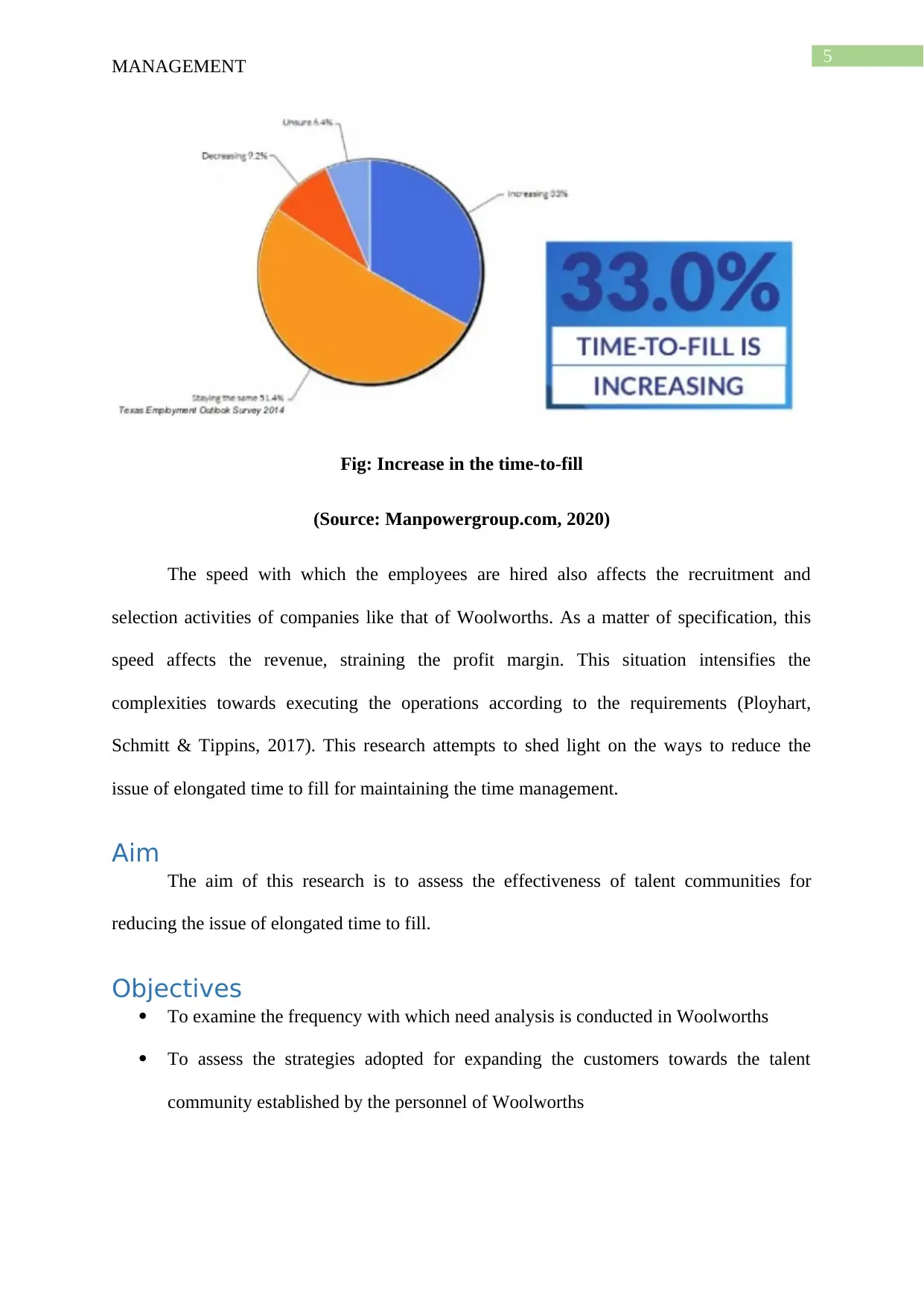
5
MANAGEMENT
Fig: Increase in the time-to-fill
(Source: Manpowergroup.com, 2020)
The speed with which the employees are hired also affects the recruitment and
selection activities of companies like that of Woolworths. As a matter of specification, this
speed affects the revenue, straining the profit margin. This situation intensifies the
complexities towards executing the operations according to the requirements (Ployhart,
Schmitt & Tippins, 2017). This research attempts to shed light on the ways to reduce the
issue of elongated time to fill for maintaining the time management.
Aim
The aim of this research is to assess the effectiveness of talent communities for
reducing the issue of elongated time to fill.
Objectives
To examine the frequency with which need analysis is conducted in Woolworths
To assess the strategies adopted for expanding the customers towards the talent
community established by the personnel of Woolworths
MANAGEMENT
Fig: Increase in the time-to-fill
(Source: Manpowergroup.com, 2020)
The speed with which the employees are hired also affects the recruitment and
selection activities of companies like that of Woolworths. As a matter of specification, this
speed affects the revenue, straining the profit margin. This situation intensifies the
complexities towards executing the operations according to the requirements (Ployhart,
Schmitt & Tippins, 2017). This research attempts to shed light on the ways to reduce the
issue of elongated time to fill for maintaining the time management.
Aim
The aim of this research is to assess the effectiveness of talent communities for
reducing the issue of elongated time to fill.
Objectives
To examine the frequency with which need analysis is conducted in Woolworths
To assess the strategies adopted for expanding the customers towards the talent
community established by the personnel of Woolworths
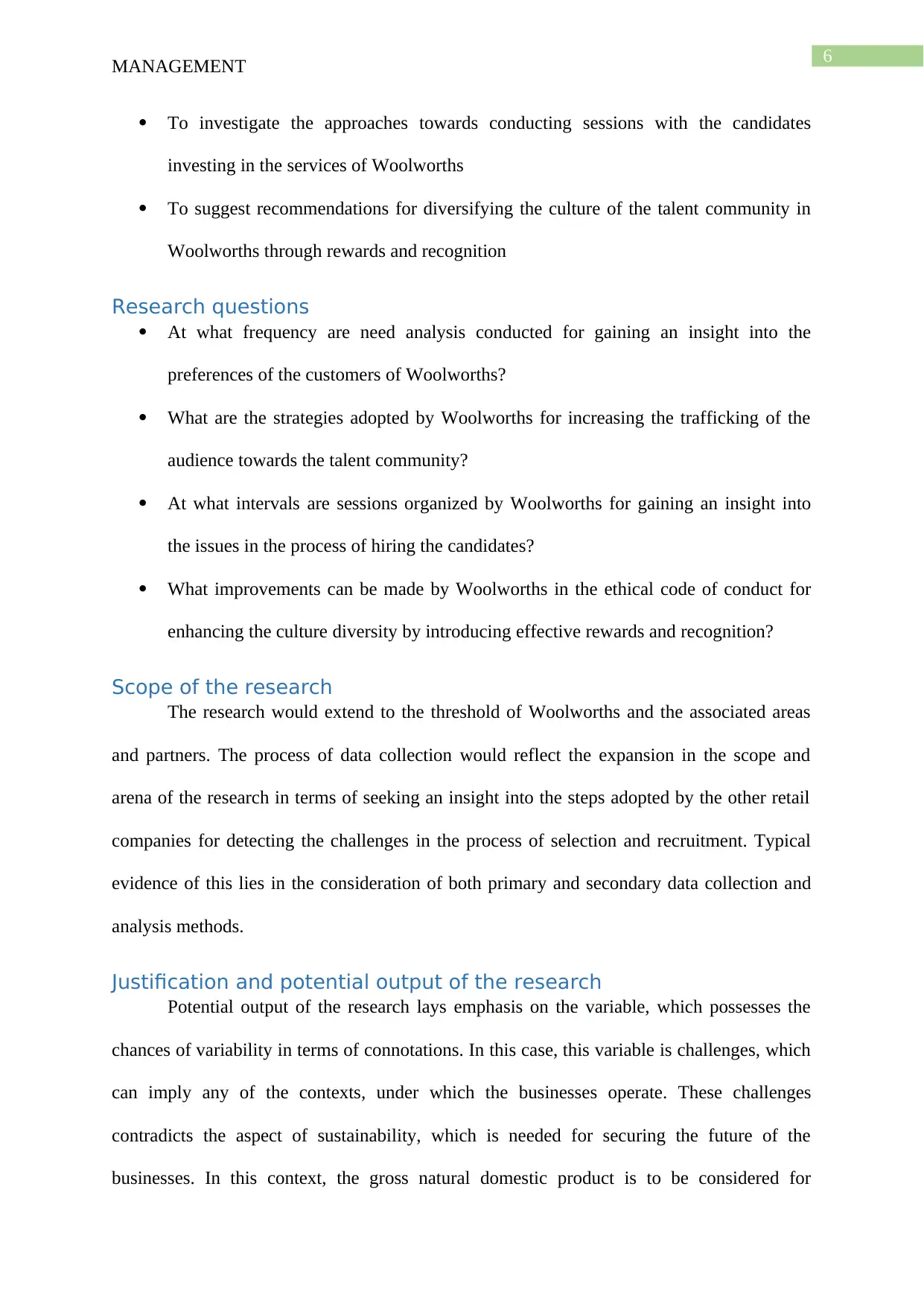
6
MANAGEMENT
To investigate the approaches towards conducting sessions with the candidates
investing in the services of Woolworths
To suggest recommendations for diversifying the culture of the talent community in
Woolworths through rewards and recognition
Research questions
At what frequency are need analysis conducted for gaining an insight into the
preferences of the customers of Woolworths?
What are the strategies adopted by Woolworths for increasing the trafficking of the
audience towards the talent community?
At what intervals are sessions organized by Woolworths for gaining an insight into
the issues in the process of hiring the candidates?
What improvements can be made by Woolworths in the ethical code of conduct for
enhancing the culture diversity by introducing effective rewards and recognition?
Scope of the research
The research would extend to the threshold of Woolworths and the associated areas
and partners. The process of data collection would reflect the expansion in the scope and
arena of the research in terms of seeking an insight into the steps adopted by the other retail
companies for detecting the challenges in the process of selection and recruitment. Typical
evidence of this lies in the consideration of both primary and secondary data collection and
analysis methods.
Justification and potential output of the research
Potential output of the research lays emphasis on the variable, which possesses the
chances of variability in terms of connotations. In this case, this variable is challenges, which
can imply any of the contexts, under which the businesses operate. These challenges
contradicts the aspect of sustainability, which is needed for securing the future of the
businesses. In this context, the gross natural domestic product is to be considered for
MANAGEMENT
To investigate the approaches towards conducting sessions with the candidates
investing in the services of Woolworths
To suggest recommendations for diversifying the culture of the talent community in
Woolworths through rewards and recognition
Research questions
At what frequency are need analysis conducted for gaining an insight into the
preferences of the customers of Woolworths?
What are the strategies adopted by Woolworths for increasing the trafficking of the
audience towards the talent community?
At what intervals are sessions organized by Woolworths for gaining an insight into
the issues in the process of hiring the candidates?
What improvements can be made by Woolworths in the ethical code of conduct for
enhancing the culture diversity by introducing effective rewards and recognition?
Scope of the research
The research would extend to the threshold of Woolworths and the associated areas
and partners. The process of data collection would reflect the expansion in the scope and
arena of the research in terms of seeking an insight into the steps adopted by the other retail
companies for detecting the challenges in the process of selection and recruitment. Typical
evidence of this lies in the consideration of both primary and secondary data collection and
analysis methods.
Justification and potential output of the research
Potential output of the research lays emphasis on the variable, which possesses the
chances of variability in terms of connotations. In this case, this variable is challenges, which
can imply any of the contexts, under which the businesses operate. These challenges
contradicts the aspect of sustainability, which is needed for securing the future of the
businesses. In this context, the gross natural domestic product is to be considered for
⊘ This is a preview!⊘
Do you want full access?
Subscribe today to unlock all pages.

Trusted by 1+ million students worldwide
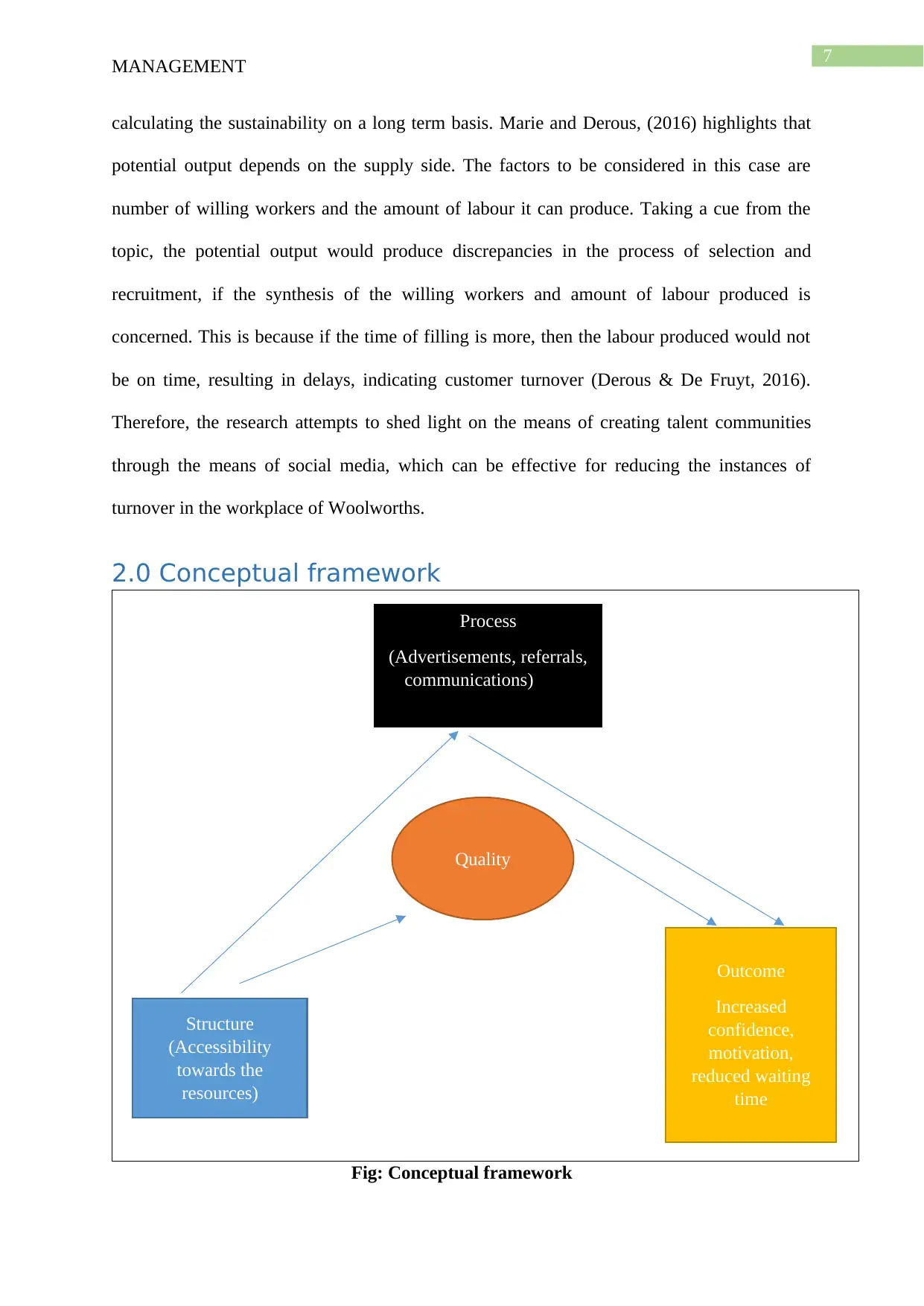
7
MANAGEMENT
calculating the sustainability on a long term basis. Marie and Derous, (2016) highlights that
potential output depends on the supply side. The factors to be considered in this case are
number of willing workers and the amount of labour it can produce. Taking a cue from the
topic, the potential output would produce discrepancies in the process of selection and
recruitment, if the synthesis of the willing workers and amount of labour produced is
concerned. This is because if the time of filling is more, then the labour produced would not
be on time, resulting in delays, indicating customer turnover (Derous & De Fruyt, 2016).
Therefore, the research attempts to shed light on the means of creating talent communities
through the means of social media, which can be effective for reducing the instances of
turnover in the workplace of Woolworths.
2.0 Conceptual framework
Fig: Conceptual framework
Process
(Advertisements, referrals,
communications)
Structure
(Accessibility
towards the
resources)
Outcome
Increased
confidence,
motivation,
reduced waiting
time
Quality
MANAGEMENT
calculating the sustainability on a long term basis. Marie and Derous, (2016) highlights that
potential output depends on the supply side. The factors to be considered in this case are
number of willing workers and the amount of labour it can produce. Taking a cue from the
topic, the potential output would produce discrepancies in the process of selection and
recruitment, if the synthesis of the willing workers and amount of labour produced is
concerned. This is because if the time of filling is more, then the labour produced would not
be on time, resulting in delays, indicating customer turnover (Derous & De Fruyt, 2016).
Therefore, the research attempts to shed light on the means of creating talent communities
through the means of social media, which can be effective for reducing the instances of
turnover in the workplace of Woolworths.
2.0 Conceptual framework
Fig: Conceptual framework
Process
(Advertisements, referrals,
communications)
Structure
(Accessibility
towards the
resources)
Outcome
Increased
confidence,
motivation,
reduced waiting
time
Quality
Paraphrase This Document
Need a fresh take? Get an instant paraphrase of this document with our AI Paraphraser
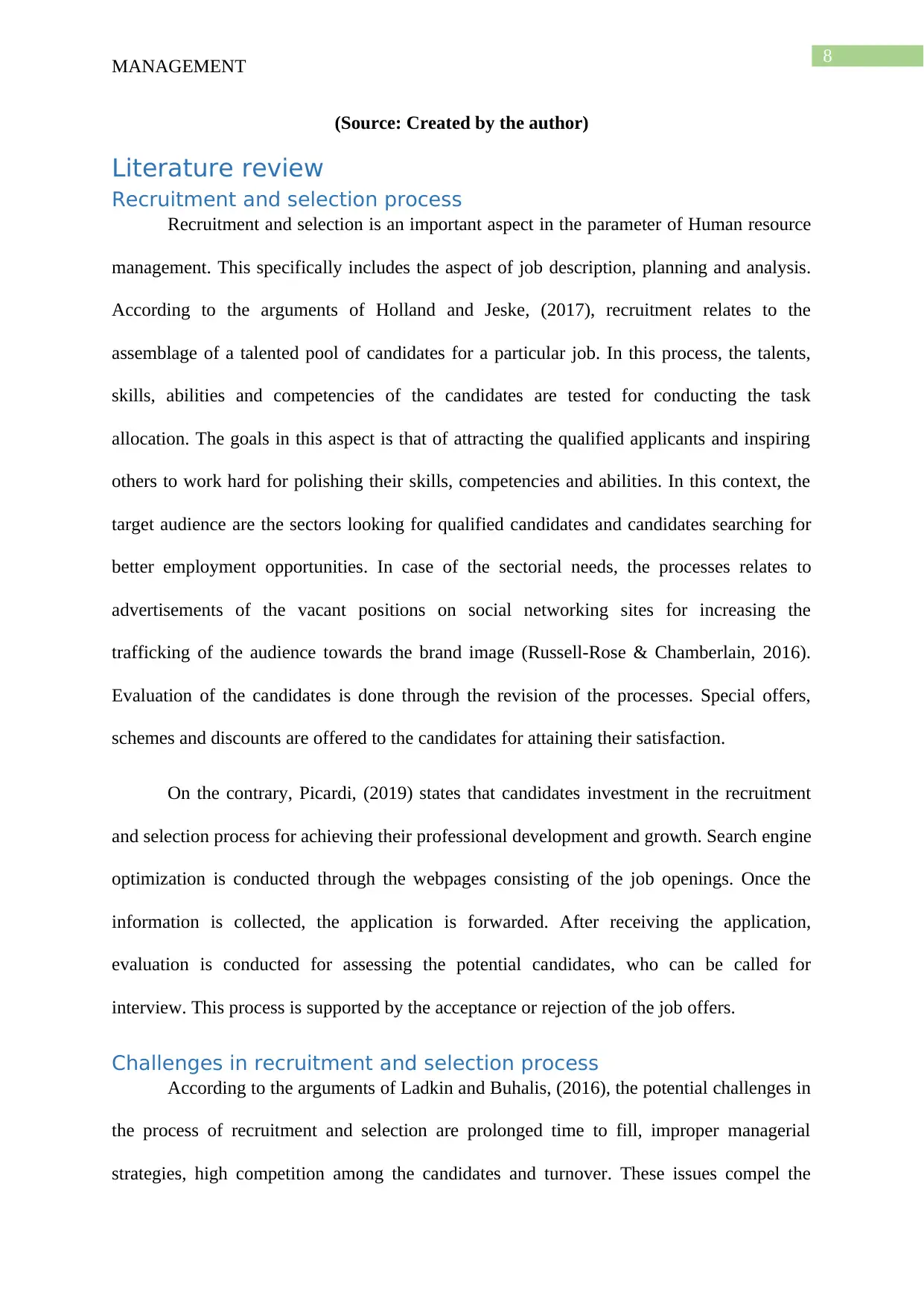
8
MANAGEMENT
(Source: Created by the author)
Literature review
Recruitment and selection process
Recruitment and selection is an important aspect in the parameter of Human resource
management. This specifically includes the aspect of job description, planning and analysis.
According to the arguments of Holland and Jeske, (2017), recruitment relates to the
assemblage of a talented pool of candidates for a particular job. In this process, the talents,
skills, abilities and competencies of the candidates are tested for conducting the task
allocation. The goals in this aspect is that of attracting the qualified applicants and inspiring
others to work hard for polishing their skills, competencies and abilities. In this context, the
target audience are the sectors looking for qualified candidates and candidates searching for
better employment opportunities. In case of the sectorial needs, the processes relates to
advertisements of the vacant positions on social networking sites for increasing the
trafficking of the audience towards the brand image (Russell-Rose & Chamberlain, 2016).
Evaluation of the candidates is done through the revision of the processes. Special offers,
schemes and discounts are offered to the candidates for attaining their satisfaction.
On the contrary, Picardi, (2019) states that candidates investment in the recruitment
and selection process for achieving their professional development and growth. Search engine
optimization is conducted through the webpages consisting of the job openings. Once the
information is collected, the application is forwarded. After receiving the application,
evaluation is conducted for assessing the potential candidates, who can be called for
interview. This process is supported by the acceptance or rejection of the job offers.
Challenges in recruitment and selection process
According to the arguments of Ladkin and Buhalis, (2016), the potential challenges in
the process of recruitment and selection are prolonged time to fill, improper managerial
strategies, high competition among the candidates and turnover. These issues compel the
MANAGEMENT
(Source: Created by the author)
Literature review
Recruitment and selection process
Recruitment and selection is an important aspect in the parameter of Human resource
management. This specifically includes the aspect of job description, planning and analysis.
According to the arguments of Holland and Jeske, (2017), recruitment relates to the
assemblage of a talented pool of candidates for a particular job. In this process, the talents,
skills, abilities and competencies of the candidates are tested for conducting the task
allocation. The goals in this aspect is that of attracting the qualified applicants and inspiring
others to work hard for polishing their skills, competencies and abilities. In this context, the
target audience are the sectors looking for qualified candidates and candidates searching for
better employment opportunities. In case of the sectorial needs, the processes relates to
advertisements of the vacant positions on social networking sites for increasing the
trafficking of the audience towards the brand image (Russell-Rose & Chamberlain, 2016).
Evaluation of the candidates is done through the revision of the processes. Special offers,
schemes and discounts are offered to the candidates for attaining their satisfaction.
On the contrary, Picardi, (2019) states that candidates investment in the recruitment
and selection process for achieving their professional development and growth. Search engine
optimization is conducted through the webpages consisting of the job openings. Once the
information is collected, the application is forwarded. After receiving the application,
evaluation is conducted for assessing the potential candidates, who can be called for
interview. This process is supported by the acceptance or rejection of the job offers.
Challenges in recruitment and selection process
According to the arguments of Ladkin and Buhalis, (2016), the potential challenges in
the process of recruitment and selection are prolonged time to fill, improper managerial
strategies, high competition among the candidates and turnover. These issues compel the
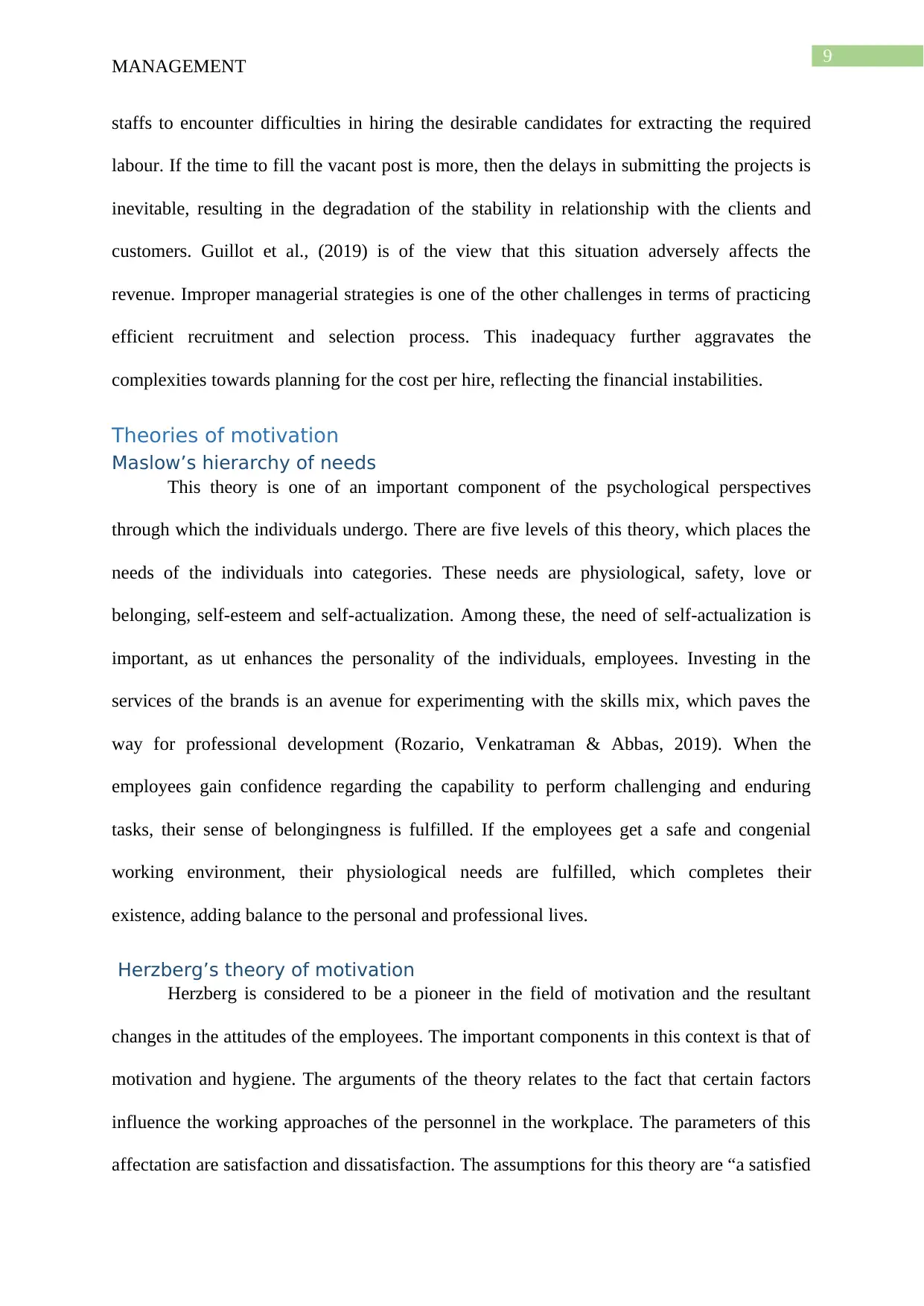
9
MANAGEMENT
staffs to encounter difficulties in hiring the desirable candidates for extracting the required
labour. If the time to fill the vacant post is more, then the delays in submitting the projects is
inevitable, resulting in the degradation of the stability in relationship with the clients and
customers. Guillot et al., (2019) is of the view that this situation adversely affects the
revenue. Improper managerial strategies is one of the other challenges in terms of practicing
efficient recruitment and selection process. This inadequacy further aggravates the
complexities towards planning for the cost per hire, reflecting the financial instabilities.
Theories of motivation
Maslow’s hierarchy of needs
This theory is one of an important component of the psychological perspectives
through which the individuals undergo. There are five levels of this theory, which places the
needs of the individuals into categories. These needs are physiological, safety, love or
belonging, self-esteem and self-actualization. Among these, the need of self-actualization is
important, as ut enhances the personality of the individuals, employees. Investing in the
services of the brands is an avenue for experimenting with the skills mix, which paves the
way for professional development (Rozario, Venkatraman & Abbas, 2019). When the
employees gain confidence regarding the capability to perform challenging and enduring
tasks, their sense of belongingness is fulfilled. If the employees get a safe and congenial
working environment, their physiological needs are fulfilled, which completes their
existence, adding balance to the personal and professional lives.
Herzberg’s theory of motivation
Herzberg is considered to be a pioneer in the field of motivation and the resultant
changes in the attitudes of the employees. The important components in this context is that of
motivation and hygiene. The arguments of the theory relates to the fact that certain factors
influence the working approaches of the personnel in the workplace. The parameters of this
affectation are satisfaction and dissatisfaction. The assumptions for this theory are “a satisfied
MANAGEMENT
staffs to encounter difficulties in hiring the desirable candidates for extracting the required
labour. If the time to fill the vacant post is more, then the delays in submitting the projects is
inevitable, resulting in the degradation of the stability in relationship with the clients and
customers. Guillot et al., (2019) is of the view that this situation adversely affects the
revenue. Improper managerial strategies is one of the other challenges in terms of practicing
efficient recruitment and selection process. This inadequacy further aggravates the
complexities towards planning for the cost per hire, reflecting the financial instabilities.
Theories of motivation
Maslow’s hierarchy of needs
This theory is one of an important component of the psychological perspectives
through which the individuals undergo. There are five levels of this theory, which places the
needs of the individuals into categories. These needs are physiological, safety, love or
belonging, self-esteem and self-actualization. Among these, the need of self-actualization is
important, as ut enhances the personality of the individuals, employees. Investing in the
services of the brands is an avenue for experimenting with the skills mix, which paves the
way for professional development (Rozario, Venkatraman & Abbas, 2019). When the
employees gain confidence regarding the capability to perform challenging and enduring
tasks, their sense of belongingness is fulfilled. If the employees get a safe and congenial
working environment, their physiological needs are fulfilled, which completes their
existence, adding balance to the personal and professional lives.
Herzberg’s theory of motivation
Herzberg is considered to be a pioneer in the field of motivation and the resultant
changes in the attitudes of the employees. The important components in this context is that of
motivation and hygiene. The arguments of the theory relates to the fact that certain factors
influence the working approaches of the personnel in the workplace. The parameters of this
affectation are satisfaction and dissatisfaction. The assumptions for this theory are “a satisfied
⊘ This is a preview!⊘
Do you want full access?
Subscribe today to unlock all pages.

Trusted by 1+ million students worldwide
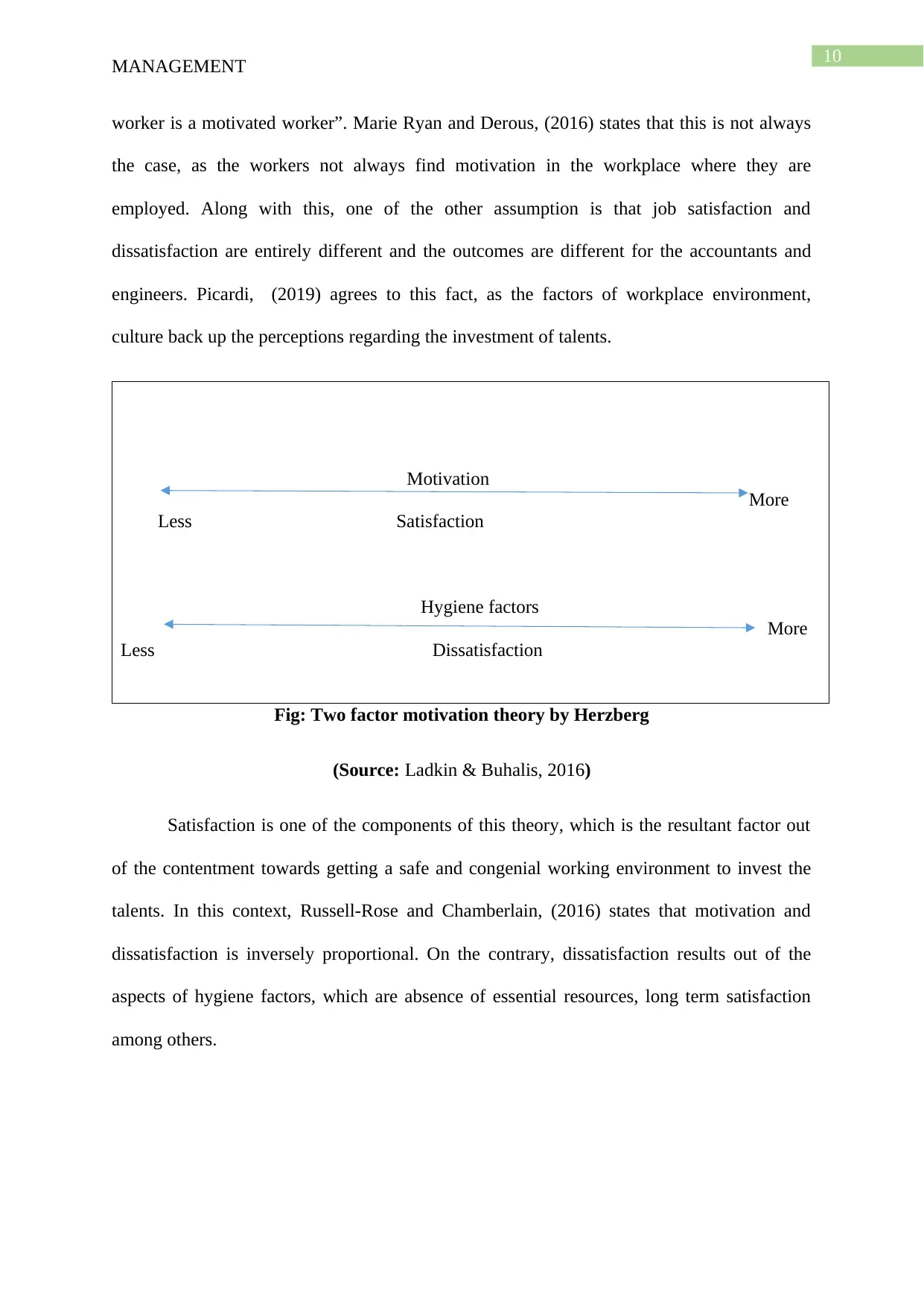
10
MANAGEMENT
worker is a motivated worker”. Marie Ryan and Derous, (2016) states that this is not always
the case, as the workers not always find motivation in the workplace where they are
employed. Along with this, one of the other assumption is that job satisfaction and
dissatisfaction are entirely different and the outcomes are different for the accountants and
engineers. Picardi, (2019) agrees to this fact, as the factors of workplace environment,
culture back up the perceptions regarding the investment of talents.
Motivation
More
Less Satisfaction
Hygiene factors
More
Less Dissatisfaction
Fig: Two factor motivation theory by Herzberg
(Source: Ladkin & Buhalis, 2016)
Satisfaction is one of the components of this theory, which is the resultant factor out
of the contentment towards getting a safe and congenial working environment to invest the
talents. In this context, Russell-Rose and Chamberlain, (2016) states that motivation and
dissatisfaction is inversely proportional. On the contrary, dissatisfaction results out of the
aspects of hygiene factors, which are absence of essential resources, long term satisfaction
among others.
MANAGEMENT
worker is a motivated worker”. Marie Ryan and Derous, (2016) states that this is not always
the case, as the workers not always find motivation in the workplace where they are
employed. Along with this, one of the other assumption is that job satisfaction and
dissatisfaction are entirely different and the outcomes are different for the accountants and
engineers. Picardi, (2019) agrees to this fact, as the factors of workplace environment,
culture back up the perceptions regarding the investment of talents.
Motivation
More
Less Satisfaction
Hygiene factors
More
Less Dissatisfaction
Fig: Two factor motivation theory by Herzberg
(Source: Ladkin & Buhalis, 2016)
Satisfaction is one of the components of this theory, which is the resultant factor out
of the contentment towards getting a safe and congenial working environment to invest the
talents. In this context, Russell-Rose and Chamberlain, (2016) states that motivation and
dissatisfaction is inversely proportional. On the contrary, dissatisfaction results out of the
aspects of hygiene factors, which are absence of essential resources, long term satisfaction
among others.
Paraphrase This Document
Need a fresh take? Get an instant paraphrase of this document with our AI Paraphraser

11
MANAGEMENT
Theories of leadership
Great man theory
According to this theory, some men are born with certain skills, differentiating them
from others. Derous and De Fruyt, (2016) contradicts that skills, qualities are attributes are
polished with age and experience. In this context, Ployhart, Schmitt and Tippins, (2017)
highlights the importance of proper application of power and authority, which helps in the
achievement of desired outcomes. Newman et al., (2018) is of the view that desire is
something, which attains a backseat in the context of the workplace rules and regulations,
where the orders and instructions are to be followed for upgrading the standards and quality
of performance. Marshall, Coleman and Reason, (2017) brings into the context, the statement
that leaders are made and not inborn. Taking a cue from this statement, Guillot et al., (2019)
establishes the fact that training is essential in terms of polishing the standards and quality of
the skills, competencies and abilities of the individuals.
Trait theory
This theory can be correlated with the great man theory, as it is assumed that certain
traits makes an individual a leader. Behavioural characteristics of the leaders are duly
followed for detecting the approach towards the allocated duties and responsibilities.
Application of the theory, clarifies the difference between the characteristic differences of the
leaders and followers. Newman et al., (2019) is of the view that the essential traits are self-
confidence, communication, ego, honesty, intelligence, integrity, sociability, determination
and flexibility. Subjective judgement is one of the aspects, which helps in mapping the
perceptions and thoughts related to tackling the issues. Considering Kirkpatrick model, it can
be stated that traits provides the leaders with the required assistance towards attaining the
necessary skills, abilities and competencies.
MANAGEMENT
Theories of leadership
Great man theory
According to this theory, some men are born with certain skills, differentiating them
from others. Derous and De Fruyt, (2016) contradicts that skills, qualities are attributes are
polished with age and experience. In this context, Ployhart, Schmitt and Tippins, (2017)
highlights the importance of proper application of power and authority, which helps in the
achievement of desired outcomes. Newman et al., (2018) is of the view that desire is
something, which attains a backseat in the context of the workplace rules and regulations,
where the orders and instructions are to be followed for upgrading the standards and quality
of performance. Marshall, Coleman and Reason, (2017) brings into the context, the statement
that leaders are made and not inborn. Taking a cue from this statement, Guillot et al., (2019)
establishes the fact that training is essential in terms of polishing the standards and quality of
the skills, competencies and abilities of the individuals.
Trait theory
This theory can be correlated with the great man theory, as it is assumed that certain
traits makes an individual a leader. Behavioural characteristics of the leaders are duly
followed for detecting the approach towards the allocated duties and responsibilities.
Application of the theory, clarifies the difference between the characteristic differences of the
leaders and followers. Newman et al., (2019) is of the view that the essential traits are self-
confidence, communication, ego, honesty, intelligence, integrity, sociability, determination
and flexibility. Subjective judgement is one of the aspects, which helps in mapping the
perceptions and thoughts related to tackling the issues. Considering Kirkpatrick model, it can
be stated that traits provides the leaders with the required assistance towards attaining the
necessary skills, abilities and competencies.
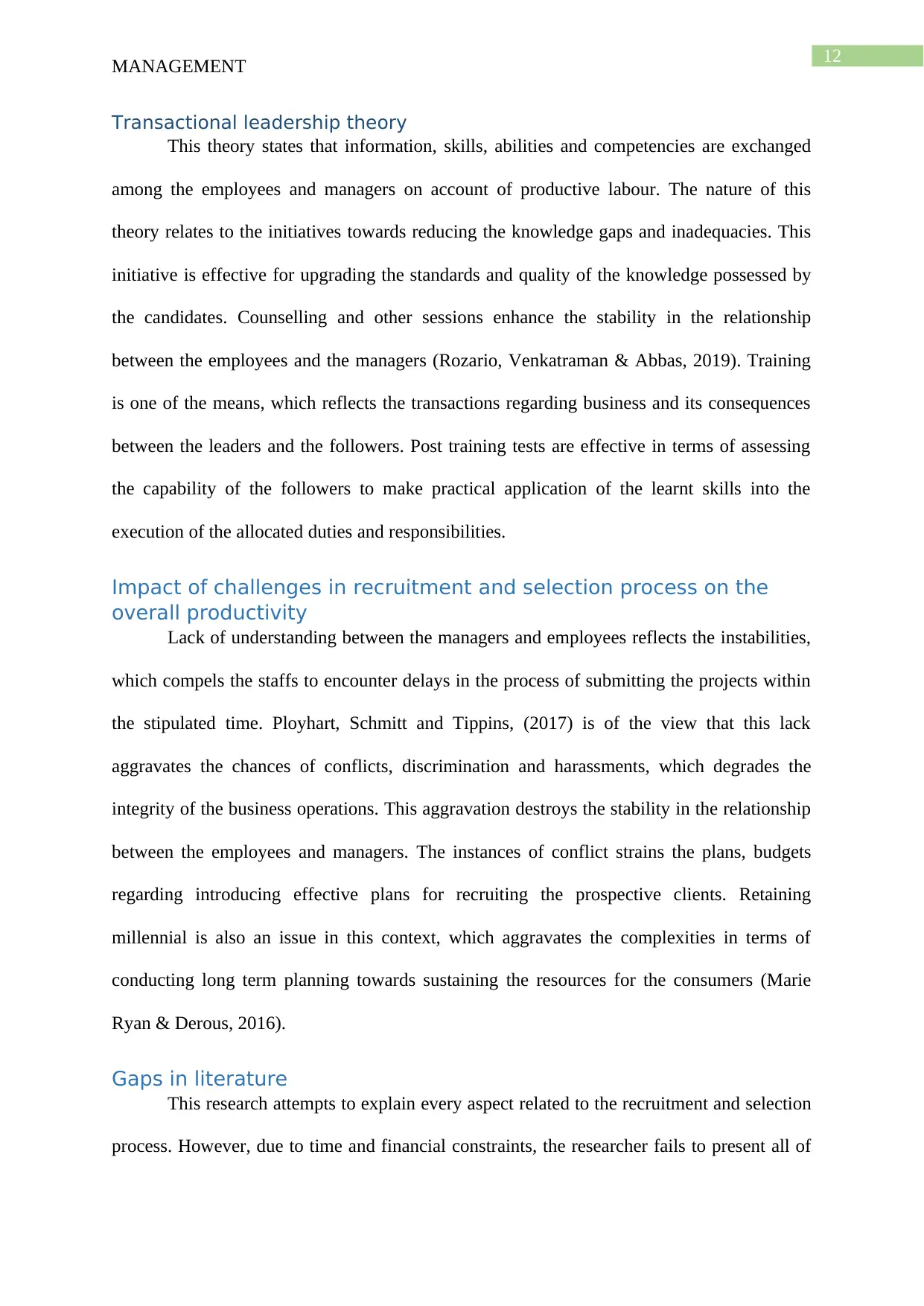
12
MANAGEMENT
Transactional leadership theory
This theory states that information, skills, abilities and competencies are exchanged
among the employees and managers on account of productive labour. The nature of this
theory relates to the initiatives towards reducing the knowledge gaps and inadequacies. This
initiative is effective for upgrading the standards and quality of the knowledge possessed by
the candidates. Counselling and other sessions enhance the stability in the relationship
between the employees and the managers (Rozario, Venkatraman & Abbas, 2019). Training
is one of the means, which reflects the transactions regarding business and its consequences
between the leaders and the followers. Post training tests are effective in terms of assessing
the capability of the followers to make practical application of the learnt skills into the
execution of the allocated duties and responsibilities.
Impact of challenges in recruitment and selection process on the
overall productivity
Lack of understanding between the managers and employees reflects the instabilities,
which compels the staffs to encounter delays in the process of submitting the projects within
the stipulated time. Ployhart, Schmitt and Tippins, (2017) is of the view that this lack
aggravates the chances of conflicts, discrimination and harassments, which degrades the
integrity of the business operations. This aggravation destroys the stability in the relationship
between the employees and managers. The instances of conflict strains the plans, budgets
regarding introducing effective plans for recruiting the prospective clients. Retaining
millennial is also an issue in this context, which aggravates the complexities in terms of
conducting long term planning towards sustaining the resources for the consumers (Marie
Ryan & Derous, 2016).
Gaps in literature
This research attempts to explain every aspect related to the recruitment and selection
process. However, due to time and financial constraints, the researcher fails to present all of
MANAGEMENT
Transactional leadership theory
This theory states that information, skills, abilities and competencies are exchanged
among the employees and managers on account of productive labour. The nature of this
theory relates to the initiatives towards reducing the knowledge gaps and inadequacies. This
initiative is effective for upgrading the standards and quality of the knowledge possessed by
the candidates. Counselling and other sessions enhance the stability in the relationship
between the employees and the managers (Rozario, Venkatraman & Abbas, 2019). Training
is one of the means, which reflects the transactions regarding business and its consequences
between the leaders and the followers. Post training tests are effective in terms of assessing
the capability of the followers to make practical application of the learnt skills into the
execution of the allocated duties and responsibilities.
Impact of challenges in recruitment and selection process on the
overall productivity
Lack of understanding between the managers and employees reflects the instabilities,
which compels the staffs to encounter delays in the process of submitting the projects within
the stipulated time. Ployhart, Schmitt and Tippins, (2017) is of the view that this lack
aggravates the chances of conflicts, discrimination and harassments, which degrades the
integrity of the business operations. This aggravation destroys the stability in the relationship
between the employees and managers. The instances of conflict strains the plans, budgets
regarding introducing effective plans for recruiting the prospective clients. Retaining
millennial is also an issue in this context, which aggravates the complexities in terms of
conducting long term planning towards sustaining the resources for the consumers (Marie
Ryan & Derous, 2016).
Gaps in literature
This research attempts to explain every aspect related to the recruitment and selection
process. However, due to time and financial constraints, the researcher fails to present all of
⊘ This is a preview!⊘
Do you want full access?
Subscribe today to unlock all pages.

Trusted by 1+ million students worldwide
1 out of 19
Related Documents
Your All-in-One AI-Powered Toolkit for Academic Success.
+13062052269
info@desklib.com
Available 24*7 on WhatsApp / Email
![[object Object]](/_next/static/media/star-bottom.7253800d.svg)
Unlock your academic potential
Copyright © 2020–2025 A2Z Services. All Rights Reserved. Developed and managed by ZUCOL.




